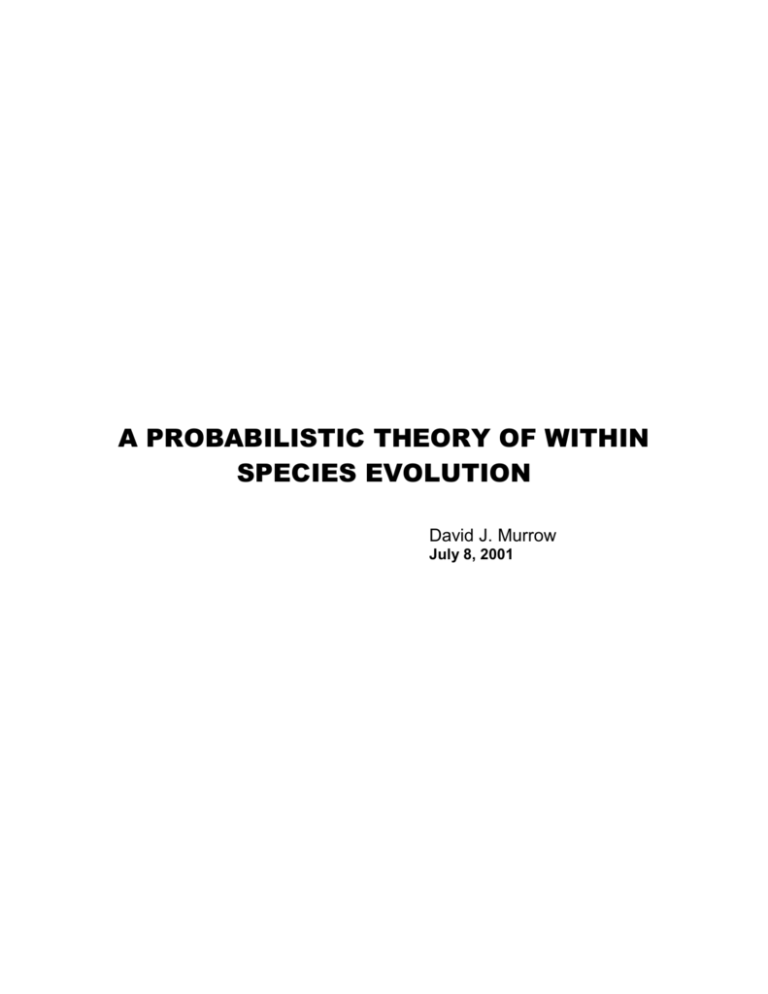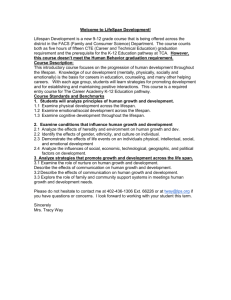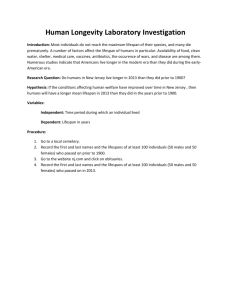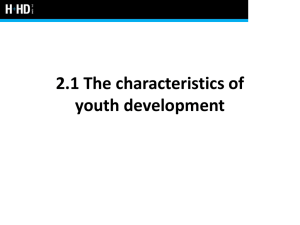
A PROBABILISTIC THEORY OF WITHIN
SPECIES EVOLUTION
David J. Murrow
July 8, 2001
A Probabilistic Theory of Within Species Evolution—D.J. Murrow
The evolution of a species over time is modelled in this paper as a random process which
is governed by the laws of probability. That this is a realistic and practical model of the
actual process of evolution is left to anthropologists, philosophers, and clergymen. What
is shown herein is merely that, if a species is affected by life events which follow the
laws of probability similar to those modelled herein, then evolution of the species will
occur over time.
The key features of the theory modelled herein are:
1) Survival/Life Expectancy
2) Natural Selection
3) Procreation Proclivity
4) Inheritance
Consider that a member of a certain species of animal life posseses a set of characteristics
, x , which can be quantified as an Nx1 vector, where each component of the vector is a
single characteristic measured by a real random number. For the purposes of this paper, if
the statistics (mean, variance, pdf, etc ) of this random variable vary over time from
generation to generation, the species is said to be evolving.
Survival/Life Expectancy
Each member k of the species is considered to have a life duration in time, which
depends in a probabilistic, or random, way on the (survival) characteristics xk possesed
by the member. Dependent random variables have a joint pdf which is the product of the
marginal pdfs with the associated conditional pdf, i.e.
p( k , xk ) p / x ( k / xk ) p x ( xk ) p x / ( xk / k ) p ( k ) .
The marginal pdfs are defined by
p x ( x)
p( , x)d ; p ( )
p( , x)dx
and the conditional pdfs are defined by
p / x ( k / xk ) p( k , xk ) / p x ( xk ); p x / ( xk / k ) p( k , xk ) / p ( k )
The expected, or mean, value of the life duration of an individual member of the species
is termed the life expectancy of the species and is given by
2
E k k p ( k )d k k p( k , x k )d k dxk k p( k / xk ) p x ( xk )d k dxk
E k / xk p x ( x k )dxk / x ( xk ) p x ( x k )dxk
where p(k) is the marginal pdf associated with the life duration of the species member
and px(xk) is the (multi-dimensional) marginal pdf associated with the physical
characteristics of the species member. The function x) is termed the conditional
lifespan of the species and is given by
/ x ( x) k p / x ( k / x)d k
Several things should be noted at this juncture. First, the life duration of a single species
member is a single real (random) number. Therefore, the first integral above is a single
integral. Second, since the physical characteristics xk of a species member is an N x 1
vector , the associated pdf is multi-dimensional and the second integral above is multidimensional. Finally, the physical characteristics of an individual member of the species
is assumed not to vary with time over its lifetime. This simplifying assumption is a
conservative one with respect to species evolution in that usually the positive physical
characteristics of a particular animal increase from childhood to adulthood. By neglecting
this time dependence of the characteristics over the lifetime of a single individual, if we
still find that a long term generational time dependence in the statistics of the
characteristics can be shown, this more strongly shows that the species is evolving.
The nature of the species conditional lifespan function /x(x) will be shown to strongly
influence the evolution of a species. Consider the variation of a single component of the
physical characteristics xn , with the other components held fixed in value, as shown in
Figure DJM-1.
/x(x)
D
C
A
B
xn
Figure DJM-1 Species Conditional Lifespan vs Physical characteristic Function Types
3
In case A above, the species conditional lifespan function increases monotonically with
its nth physical characteristic. In other words, the greater the value of the measure of the
nth characteristic xn , the greater the lifespan of the a species member with the given
physical characteristic value .
In case B above, the species conditional lifespan function decreases monotonically with
its nth physical characteristic. In other words, the greater the value of the measure of the
nth characteristic xn , the lesser the lifespan of the a species member with the given
physical characteristic value .
In case C above, the species conditional lifespan function decreases with its nth physical
characteristic until it reaches a minimum and then increases for greater values of the nth
physical characteristic.
In case D above, the species conditional lifespan function increases with its nth physical
characteristic until it reaches a maximum and then decreases for greater values of the nth
physical characteristic.
Survival/life expectancy dependence on physical characteristics alone will not produce
evolution within a species. Procreation and inheritance are also required.
Natural Selection
Not all species mate for procreation. Those that do are divided into two sexes, male and
female. Natural selection refers to the tendency in prospective mates from the two sexes
to prefer values of x in their partner's physical characteristics which enhance the
survival/life expectancy of the species. Let member #m be a male member of the species
and member #f be a female member. Then xm and xf are the two sets of physical
characteristics possesed by the two members. The corresponding conditional life
expectancies are x(xm) and x(xf). A reasonable model for natural selection would call
for the likelihood of mating between two members of the opposite sex with drastically
different conditional life expectancies to be small. Let m,f = xm , xf ) be the average
rate of mating between male member m and female member f, and let m,f = x(xm) x(xf) be the difference in their conditional life expectancies . A reasonable model for
natural selection would appear as in Figure DJM-2. Even if the life expectancies of two
members are close, they may not mate due to failure to meet or other factors. Let pM(m,f)
be the probability that two specified members of the opposite sex meet during their
lifetime
4
m,f
m,f
Figure DJM-2 Natural Selection--Relationship Between Mating Rate and Conditional
Life Expectancy
let ym,f =1 if members m and f meet during their lifetime and ym,f =0 otherwise.
Then a reasonable model for couples meeting is the binomial pdf
py(m,f)=(pM(m,f))y (1-pM(m,f))(1-y)
Procreation Proclivity
In single sex species, the number of offspring produced by a member during its lifespan
may be dependent on the physical characteristics xk of the member and on its lifespan k .
A reasonable model for such procreation is the Poisson process, i.e.,
p nk (nk / x k , k ) ( k ) nk e k / nk ! nk=0,1,2,…
where k = (xk)k
In dual sex species, the number of offspring produced by a pair of opposite sex members
during their lifespan may be dependent on the physical characteristics xm and xf of the
members and on their lifespan m,f = min(m , f ) . A reasonable model for such
procreation is the Poisson process, i.e.,
pn (nm, f / xm , x f , m, f , y m, f ) ( m, f )
nm , f
e
m , f
/ nm , f !
where m,f = (xm,xf)y(m,f)m,f .
5
Inheritance
In single sex species, physical characteristics are passed on to a members offspring in a
probabilistic way. Let the parent be member k, with physical characteristic xk and let the
child be member j, with physical characteristic xj . The inheritance characteristic would
be modelled by the conditional inheritance pdf pI(xj/xk).
In dual sex species, physical characteristics are also passed on to pair of opposite sex
members offspring in a probabilistic way. Let the parents be members m and f, with
physical characteristic xm and xf and let the child be member j, with physical
characteristic xj . The inheritance characteristic would be modelled by the conditional
inheritance pdf pI(xj/xm , xf).
Note that deterministic (non-random) inheritance can be forced by taking the pdfs to be
Kronecker delta functions, e.g,
p I ( x j / xk ) ( x j xk )
or
p I ( x j / x m , x f ) ( x j ( x m x f ) / 2)
In these cases the characteristics of the parent(s) would be passed on to the children in a
fixed, deterministic manner.
6
Some example numerical results are next presented. The single sex species case is
simpler mathematically and so is used in the following example. Consider a species of
microbe whose dominant physical characteristic is , say, its length. At time zero, we may
start with a small set (say 10) of members of the species whose lengths are random draws
from a normally distributed pdf with a mean of 10 micometers and a standard deviation
of 1 micrometer. This pdf is illustrated in Figure DJM-1a.
Example: Microbe Size Evolution
Initial Size Distribution
Conditional Life Expectancy
T/x=100/(1+((x-xT)/
=100/(1+((x-xT)/)4)
p(x)=exp(-(x-xb)2/2
/22 )/(2
)/(22)1/2
xb=10
=1
Lifespan Distribution
xT=20
=5
Procreation Proclivity
conditional life expectancy
=...50,60,70,80,...
p(T)=4exp(-0.8( t/
t/))5 )( t/
t/))4 /
/
Figure DJM-1 Probabilistic Models for Example Microbe Species Characteristics
From a survivability viewpoint, it is conceivable that a member of such a microbe species
might be less likely to survive if it were too short or too long, and more likely to survive
if it were near some optimal survival length. Such a function is shown in Figure DJM-1b,
where an example conditional life expectancy function is shown plotted against the
length of a microbe. This function peaks at 100days of life expectancy for a length in the
neighborhood of 20micometers, and falls off rapidly on either side of the optimum
survival length. The actual lifespan of a member is a random draw from some pdf with
life expectancy as a parameter. An example pdf with reasonable characteristics is shown
in Figure DJM-1c. A member microbe may produce a number of offspring during its
lifespan. It is reasonable to take the expected rate of offspring production to be a fixed
property of the microbe species. For example, suppose it is an offspring per 5 days on
average, or 0.2 offspring per day. The expected number of offspring in a particular
7
members whose lifespan was 50 days would then be 10. A commonly used model for the
actual number of offspring would be the Poisson pdf.
The Poisson pdf for various mean values is illustrated in Figure DJM-2.
Poisson Procreation Distribution
Expected (mean)
# Offspring=1
Expected (mean)
# Offspring=10
Figure DJM-2 Poisson PDF with Various Expected Values
For this example, the length of an offpsring microbe is taken here to be a normally
distributed random variable with an expected (or mean) length equal to that of it's parent's
actual length and a standard deviation of 1 micrometer.
8
Figure DJM-3 shows a single representative Monte Carlo trial of the resultant (random)
population of the species versus time, along with the evolution of the species in length,
lifespan, and number of offspring. This figure clearly shows that the microbe population
is growing and that the species is evolving toward greater length, greater lifespan, and
more offspring.
Figure DJM-3 Representative Evolution of the Example Microbe Species
Thus, under favorable probabilistic survival and propagation conditions, the average
physical characteristics of a species will evolve over time.
9







